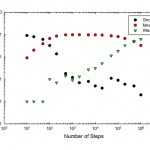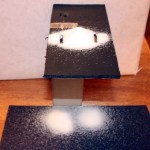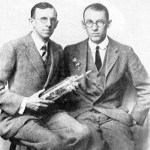Quantum Optics
It's been a while since I last rounded up physics posts from Forbes, so there's a good bunch of stuff on this list:
-- How Do Physicists Know What Electrons Are Doing Inside Matter?: An explanation of Angle-Resolved Photo-Electron Spectroscopy (ARPES), one of the major experimental techniques in condensed matter. I'm trying to figure out a way to list "got 1,800 people to read a blog post about ARPES" as one of my professional accomplishments on my CV.
-- The Optics Of Superman's X-Ray Vision: Spinning off a post of Rhett's, a look at why humanoid eyes just aren't set up to work with x-rays…
A long-ish stretch of time, but I was basically offline for a bunch of that because I needed to finish a chapter I was asked to contribute to an academic book. So there are only four physics posts from Forbes to promote this time:
-- 'The Expanse' Is A Rare Sci-Fi Show That Gets Simulated Gravity Right: Another post on the SyFy adaptation of "James S. A. Corey"'s books, talking about a nifty bit of visual effects that nods at the Coriolis force you'd see on a rotating space station.
-- What Is The Quantum Pigeonhole Principle And Why Is It Weird?: A paper published in the Proceedings of the…
I've been slacking in my obligation to use this blog for self-promotion, but every now and then I remember, so here are two recent things where I was interviewed by other people:
-- I spoke on the phone to a reporter from Popular Mechanics who was writing a story about "radionics" and "wishing boxes," a particular variety of pseudoscience sometimes justified with references to quantum mechanics. The resulting story is now up, and quotes me:
It is hard to investigate the ethereal thinking around radionics, but physics is something that can be parsed. So I got in touch with Chad Orzel, a…
I forgot to do this last week, because I was busy preparing for SteelyPalooza on Saturday, but here are links to my recent physics posts over at Forbes:
-- What 'Ant-Man' Gets Wrong About The Real Quantum Realm: On the way home from the Schrödinger Sessions, I had some time to kill so I stopped to watch a summer blockbuster. The movie was enjoyable enough, thanks to charming performances from the key players, but the premise is dippy even for a comic-book movie. It does, however, provide a hook to talk about quantum physics, so...
-- Great Books For Non-Physicists Who Want To Understand…
There's a new Science Express paper on interfering clocks today, which is written up in Physics World, with comments from yours truly. The quote is from a much longer message I sent-- with no expectation that it would end up as anything other than a pull quote, I might add, but I thought the background would be helpful. Since I ended up doing a back-of-the-envelope estimate for that, though, I thought I would reproduce some of the reasoning here.
The basic proposal idea here is to do an atom interferometer inside a Ramsey interferometer for making an atomic clock. That is, before sending the…
I've been really busy with year-end wrap-up stuff, but have also posted a bunch of stuff at Forbes. which I've fallen down on my obligation to promote here... So, somewhat belatedly, here's a collection of physics-y stuff that I've written recently:
-- Using Atoms To Measure Tiny Forces: A post reporting on some very cool atom interferometry experiments, one working to measure the very tiny (but known to exist) force of gravity, the other searching for a possible "fifth force" sort of thing.
-- Making And Shaking New Materials With Ultracold Atoms: A post reporting on a couple more DAMOP…
Last week, I did a post for Forbes on the surprisingly complicated physics of a light bulb. Incandescent light bulbs produce a spectrum that's basically blackbody radiation, but if you think about it, that's kind of amazing given that the atoms making up the filament have quantized states, and can absorb and emit only discrete frequencies of light. The transition from the line spectra characteristic of particular atoms to the broad and smooth spectrum of black-body radiation is kind of amazing.
The way you get from the one to the other is through repeated off-resonant scattering. The…
I was proctoring an exam yesterday in two different sections of the same class, so I had a lot of quite time. Which means I wrote not one but two new posts for Forbes...
The first continues a loose series of posts about the exotic physics behind everyday objects (something I'm toying with as a possible theme for a new book...), looking at the surprisingly complicated physics of an incandescent light bulb. A light bulb filament emits (to a reasonable approximation) black-body radiation, which is historically important as the starting point for quantum physics. But when you think about it, it's…
I'm still in the late stages of an awful cold, but shook it off a bit to write a new conversation with Emmy, the Queen of Niskayuna over at Forbes:
“HEY! YOU POODLES! STAY OFFA MY LAWN!”
“Emmy! Stop barking!” I sit up. She’s at the gap between the fences, where she can see into the front yard.
“But, those poodles..”
“We’ve had this conversation. It’s a public street, other dogs are allowed to walk on it. No barking.” She comes over, sheepishly. “Why can’t you just lie down and enjoy the nice day, hmm?”
“Well, I would. But, you know… Quantum.”
“What?”
“I would love to just lie in the sun, but…
As mentioned over the weekend, I gave a talk last week for UCALL, part of a series on "The Radical Early 20th Century." I talked about how relativity is often perceived as revolutionary, but isn't really, while Einstein's really revolutionary 1905 paper is often overlooked. And, having put the time into thinking about the subject, I turned the basic theme into a new blog post over at Forbes:
Albert Einstein is easily one of the most recognizable people in history, and everybody thinks they know why. He’s the guy who, in 1905, completely revolutionized physics, overthrowing the prior order…
Two roads diverged in a yellow wood, And caused me no small amount of panic For traveling both of them would be good But there simply was no way I could Until I remembered quantum mechanics.
So half my wavefunction I sent left And rightward steered the other half Both pieces of me with equal heft And thanks to calculations deft, I knew the end would sum both paths
Plenty of physicists claim to know Or at least will confidently speculateThat collapse, or a pilot wave's flow, Or decoherence act to make it so. Me, I just shut up and calculate.
So in the woods I went two ways To return together…
A few years back, I became aware of Mike Brotherton's Launch Pad Astronomy Workshop, and said "somebody should do this for quantum physics." At the time, I wasn't in a position to do that, but in the interim, the APS Outreach program launched the Public Outreach and Informing the Public Grant program, providing smallish grants for new public outreach efforts. So, because I apparently don't have enough on my plate as it is, I floated the idea with Steve Rolston at Maryland (my immediate supervisor when I was a grad student), who liked it, and we put together a proposal with their Director of…
Phillip Ball has a long aggrieved essay about the Many-Worlds Interpretation, which is, as Sean Carroll notes, pretty bad. Ball declares that Many-Worlds is "incoherent, both philosophically and logically," but in fact, he's got this exactly backwards: Many-Worlds is, in fact, a marvel of logical and philosophical coherence, while Ball's objections are incoherent and illogical.
The fundamental problem with Many-Worlds is that every argument about it devolves very quickly into stoner dorm-room bull session nonsense about parallel worlds and identity and morality. But none of that is physics.…
Rhett Allain has a list of 5 Things Every Human Should Know About Light, to tie in with the International Year of Light, and it's a good list with lots of .gifs. Of course, there are some gaps, so let me offer some additional things that everyone ought to know about light:
-- Light Is a Particle
Rhett and I have a long-running argument about the use of photons in introductory physics; he's against them for reasons that make no sense to me. To my mind, it is unquestionably true that light has particle-like properties (and here's a follow-up with some math), and that's a thing that everybody…
Over at Scientific American's Frontiers for Young Minds blog, they have a great post on what happens when you ask scientists to explain key elements of a different research field. It's pretty funny, and rings very true, as SteelyKid asks me tons of science questions, very few of which have anything to do with atomic, molecular, or optical physics. so I spend a lot of time faking my way through really basic explanations of other fields.
Of course, even pitching stuff from my own field at the right level for small kids is a challenge. Which reminds me, I never did explain my presentation for…
Over on Facebook, my colleague Chris Chabris was talking up a smartphone game from a company he's associated with. Which of course got me thinking "Wait, why don't I have a smartphone game company?" (The Renaissance Weekend is also partly to blame, as I was one of about six people there who didn't have a start-up company of some sort...) Which, in turn, led to the realization that there really ought to be a quantum optics video game. Or maybe a series of games, because you could construct a whole bunch of puzzlers around quantum phenomena:
-- The most basic would be to do something like the…
As I endlessly repeat, I'm an experimentalist by training an inclination, so I especially appreciate stories about experimental science. There's something particularly wonderful about the moment when an experiment clicks together, usually after weeks or months of hard, frustrating work, when things just keep breaking.
Of course, sometimes, breaking stuff can be a Good Thing.
Possibly my favorite story from the development of quantum physics involves just such an occasion, around 1924, when Clinton Davisson and Lester Germer at Bell Labs were trying to characterize a nickel surface by bouncing…
Back in August, I gave a talk in Stockholm at the Nordita workshop for science writers, about precision measurement searches for physics beyond the Standard Model. There's now video of this online:
The video quality isn't great, but if you'd like a clearer look at the slides, I've posted them on SlideShare. The talk was divided into two parts, though the video is not:
Part 1:
High Precision, Not High Energy: Using Atomic Physics to Look Beyond the Standard Model (Part I) from Chad Orzel
Part 2:
High Precision, Not High Energy: Using Atomic Physics to Look Beyond the Standard Model (…
In odd-numbered years (by the Gregorian calendar, anyway), the University of Toronto offers the John Stewart Bell Prize for Research on Fundamental Issues in Quantum Mechanics and Their Applications. This is not connected to the Jon Stewart of the Daily Show-- he's purely classical, as you can tell from the fact that there's no "h" in his name. It honors the great Irish physicist John Bell, whose theorem showing that quantum models could be experimentally distinguished from local hidden variable theories helped kick off the thriving field of quantum information. (Bell's contribution is a big…
The fourth video I wrote for TED-Ed is now live: Einstein's Brilliant Mistake: Entangled States. The title is not just an Elvis Costello reference, but gets at the fact that while the Einstein, Podolsky, and Rosen paper was wrong in that the local hidden variable theories they favored are impossible, it turned out to be important and productive.
As with the others, I'm very happy with the way this came out. The images are great, and I'm glad to get in the point that Bell's key insight involves measuring different properties for the two particles, which is sometimes glossed over. It was…




